2 Printer Setup
This chapter describes basic setup of the F120 printer.
The printer’s Welcome Kit contains the Welcome Insert document and common tools you will need to maintain the printer. Use the following figures and tables to identify the contents of the Welcome Kit.
Figure 1: Welcome Kit Contents - Documents and Cables
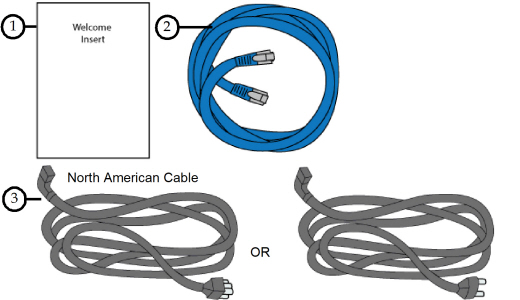
|
# |
Item |
Description |
|---|---|---|
|
1 |
Welcome Insert Document |
Contains instructions for downloading the F120 User Guide (this document). |
|
2 |
RJ45 Cable |
This cable is used to establish a network connection between the F120 printer and your Ethernet network. See “Making the Network Connection” (page 3). |
|
3 |
AC Cable (North American or European) |
This cable provides the power connection to the printer. See “Connecting the Power Cable” (page 4). Select the appropriate cable for your location (North American cable or European cable). |
Figure 2: Welcome Kit Contents - Tools
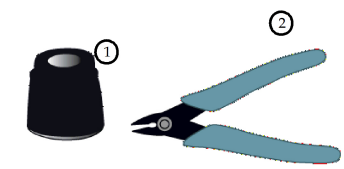
|
# |
Item |
Description |
|---|---|---|
|
1 |
Loupe Magnifier |
This tool is included to aid you with performing a Manual Tip Calibration which requires you to view small toolpath relationships. See “Manual Tip Calibration” (page 5). |
|
2 |
5” Cutter |
These are used to cut a material coil box’s filament when unloading and removing materials from the printer. See “Unloading Material” (page 11). |
Follow the Site Preparation Guide to ensure that your facility is effectively and safely prepared for printer installation. Do not proceed with the following sections until the “Unpacking the Printer” section of the Site Preparation Guide has been completed. When installation is complete, perform the following setup tasks.
•Open the top cover and ensure that the orange clip has been removed from the X belt, and the orange tie wrap has been removed from the X motor. If not, remove the orange clip and/or orange tie wrap securing these components.
•Verify that minimum space requirements have been met.
|
Side |
Clearance |
|---|---|
|
Right Side Clearance |
Minimum 20 inches (50.8 cm) |
|
Left Side Clearance |
Minimum 4 inches (10.16 cm) |
|
Rear Clearance |
Minimum 6 inches (15.24 cm) |
|
Front Clearance |
Minimum 20 inches (50.80 cm) |
|
Overhead Clearance |
Minimum 20 inches (50.80 cm) |
Use the following tags to identify your printer:
•Serial Number Tag - Refer to this number when requesting service. You can also locate the printer’s serial number via the Maintenance page of the User Interface (see “System Odometers” (page 56) for more information).
•Model Tag - The printer’s model number, part number and power requirements are given on this tag. This tag also lists all patent numbers associated with the printer, some FCC compliance information, voltage warnings, and the Stratasys web address.
Both tags are located on the back side of the printer near the bottom, and are typically placed near the printer’s power connection. Use the information on these tags when identifying your printer with Customer Support.
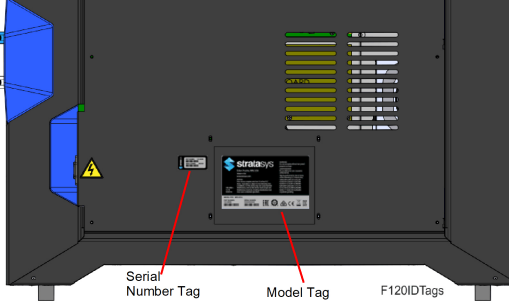
Processed job files can be transferred from GrabCAD Print to the F120 printer through your facility’s Ethernet network. An RJ45 network connector is located on the right, rear corner of the printer (as viewed from the rear). See Figure 4 for the network connection location.
|
|
A 15 foot (4‘.6m) network patch cable is supplied with the printer and located in the welcome kit. Facilities having network connection points further from the printer than can be reached by the supplied cable are responsible for the procurement of an appropriate cable. |
|
|
Caution For users in Japan; A power cable is provided for connecting the printer to the AC electric source. Do not use it with other equipment. |
To connect the power cable:
1.Connect the male end of the supplied power cord (US or European) directly into a grounded electrical outlet.
2.Connect the female end of the power cord directly into the socket located on the back of the printer (see Figure 4).
|
|
Warning: Electrical Shock Hazard. The power cord serves as the disconnect device. The socket outlet must be easily accessible. |
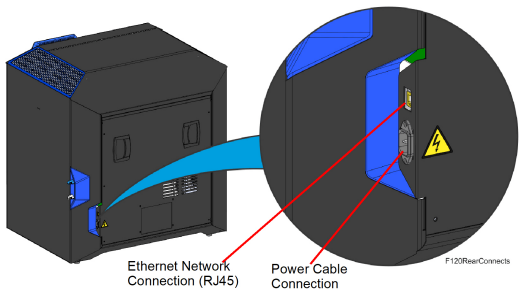
This section is provided in case you need to change your network settings. Within the Network page you can set your printer’s address type to Static, Dynamic (DHCP), or Wi-Fi; Dynamic is selected by default.
•Static address - you must enter an IP address, subnet mask, and gateway address for the printer (provided by the system administrator). Once entered, the address will not change.
•Dynamic address (DHCP) - a network server or PC will generate an IP address for the printer. A different IP address may be generated from time to time by the server or PC.
•Wi-Fi address - the printer will scan for and allow you to connect to an available Wi-Fi network (if the Wi-Fi dongle has been installed).
To configure your printer’s network address settings:
1.Power ON the printer, see “Powering ON the Printer” (page 1).
2.Open the Tools page by pressing the Tools button within the Navigation Menu (see Table 1 (page 2)).
3.Open the Network page by pressing the Network button within the Tools page (see Figure 35 (page 37)).
4.The Connection Type row allows you to select between a wired or wireless network. The option selected will determine the configurable settings displayed within the Network page.
•Selecting the Wired option will allow you to select between a Dynamic or Static network mode.
•Selecting the Wireless option will configure the pinter to use a Wi-Fi network. You will need to scan for a wireless network and enter the security settings for the selected network (if required) to complete the configuration. Please note that the availability of the Wireless option depends upon the configuration purchased with your printer.
5.After selecting the radio button corresponding to the connection type you’d like to use (wired or wireless) press the Back button in the upper-left corner of the page to return to the Network page.
6.For wired networks:
a.The Network Mode row will be displayed. Press anywhere within this row.
b.Select either the Static or Dynamic radio button to enable that network address type. Depending on the option selected, you may need to configure additional information within the Network page.
Figure 5: Wired Network Selection
•If the Static option is enabled, you must manually configure the IP Address, Subnet Mask, and Gateway Address fields.To configure this information simply touch a field on the screen to select it and then use the keypad displayed to enter address information.
i.Touch anywhere on the screen outside of the keypad to exit and close the keypad.
Figure 6: Static Network Configuration
ii.Scroll to the bottom of the page and press the Apply button when finished to save the network configuration.
iii.Press the Back button in the upper-left corner of the page to return to the Network page.
Figure 7: Apply Changes Button
•If the Dynamic option is enabled, no additional configuration is necessary as a network server or PC will automatically generate an IP address for the printer. A different IP address may be generated from time to time by the server or PC; the generated IP address will be displayed within the IP Address field of the Network page, and corresponding Subnet Mask and Gateway Address information will also be displayed.
•Press the Back button to exit the page and return to the Tools page.
Figure 8: Dynamic Network Configuration
7.For wireless networks:
c.The Available Networks row will be displayed (Wi-Fi dongle must be installed). Press anywhere within this row.
d.Press the Scan button; the printer will scan for an available wireless (Wi-Fi) network.
Figure 9: Scan for Wireless Network
e.A list of available networks will be displayed; select the wireless network you’d like to connect to by pressing anywhere within the row.
f.A page will be displayed containing the details of the selected Wi-Fi network. Within this page use the keyboard to enter the password and/or username required to connect to the network.
Figure 10: Enter Wi-Fi Network Information
g.When finished, touch anywhere on the screen outside of the keypad to exit and close the keypad.
h.Scroll to the bottom of the page and press the Connect button to save the network configuration.
i.Press the Back button to exit the page and return to the Network page. The name of the selected wireless network will be displayed within the Available Networks row.
j.Press the Back button to exit the page and return to the Tools page. The Network button will refresh and a blue indicator will be displayed indicating that the printer is configured for a Wi-Fi network.
Figure 12: Enter Network Settings Dialog
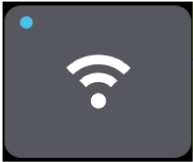
Install the GrabCAD Print software on a facility workstation. Navigate to http://help.grabcad.com/article/197-sign-up-download-and-install and follow the on-screen instructions. While on the GrabCAD website, be sure to join the F120 User’s Group.
Connecting to the F120 Printer
Add the F120 printer to the GrabCAD Print application. Navigate to http://help.grabcad.com/article/198-connect-your-printers and follow the on-screen instructions.
Setting the Printer’s Date and Time
|
|
When setting the printer’s date and time, the printer must be in an idle state. |
In order to ensure accurate build times, the printer’s clock must be set correctly. If you find that your printer’s date and/or time are incorrect you can update them using GrabCAD Print. To do so, navigate to http://help.grabcad.com/article/196-printer-firmware-management and follow the procedure for “Changing your printer’s clock time”.
Updating the Controller software Version
|
|
When updating the printer’s controller software version, the printer must be in an idle state. |
Update the Controller Software if necessary. See “Updating Controller Software” (page 1).
If necessary, adjust the tip wipe height. See “Tip Wipe Height Adjustment” (page 17).